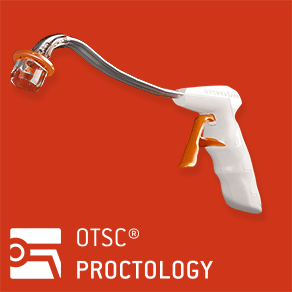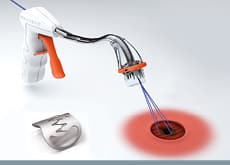OTSC® Proctology is a valuable alternative treatment option for complex anal fistulas
A retrospective study of the use of the OTSC Proctology in 61 patients with complex pre-treated anorectal fistulas reveals a healing rate of 44% after 12 months. Healing for suprasphincteric and high transsphincteric fistulas could be achieved in 63%, and for Crohn’s disease (CD) associated fistulas in 42%. Anal continence after fistula closure by the OTSC Proctology was preserved in 60/61 patients.
S. Hannes et al., Department of Surgery and Coloproctology, DKD Helios Klinik Wiesbaden, Germany, aimed to assess the effectiveness and tolerability of OTSC Proctology as an innovative procedure for anorectal fistula closure when conventional treatments had failed or were not feasible.
The retrospective study included 66 consecutive anal fistula closures in 61 patients (median age: 50.5 years; 61% male) treated between March 2014 and March 2016 with the OTSC Proctology. The primary outcome was the healing rate (defined as closure of the internal fistula ostium and absence of secretion or local inflammation during follow up), with a minimum follow-up of 6 months. Secondary endpoints were complications and unplanned reoperations.
The etiology involved cryptoglandular fistulas in 68% of cases (45/66), fistulas associated with CD in 29% of cases (19/66), and other non-cryptoglandular fistulas in 4% of cases (2/66). Previous therapy had failed in 47% of fistulas (31/66). In this specific group, successful fistula closure was achieved in 29/66 of cases (44%) after a median follow-up period of 40 months (6–61 months). The healing rates for suprasphincteric and high transsphincteric fistulas were 63%, and 42% in CD associated fistulas. In 21/66 (32%) of cases, the fistula was persistent and in 12/66 (18%) of cases recurrent. In most cases (50/66, 76%), a seton was inserted before closure with the OTSC Proctology clip for a median time of 175 days (range 42–1546 days). Median operating time was 25 min (range 14–90 min). Patients were discharged after a median stay of 7 days (range 1–14).
Removal of the clip was performed in 46/66 cases (70%). In three of those patients, the OTSC Proctology clip was removed because of an adverse event: due to inflammation (n=1; removal after 7 days), due to supraanal stenosis (n=1; removal and dilatation after 11 days), and due to mechanical irritation (n=1; removal after 3 years). In the remaining 43 cases, the clip was removed electively. The OTSC Proctology clip was lost in 9/66 cases (14%) spontaneously. Sufficient closure of the internal ostium failed in 3 patients: in one case due to the large size of the internal ostium and in two cases due to dislocation of the OTSC Proctology clip after 5 and 6 days. Anal continence after fistula closure by the OTSC Proctology was preserved in all patients except in one patient with CD.
The authors conclude that use of the OTSC Proctology for anorectal fistula closure represents an innovative and sphincter-preserving treatment strategy with low adverse events. It can lead to long-term healing in complex anorectal fistulas, especially in cases where conventional treatments have proven ineffective.
Hannes S, Kochergin M, Al-Haidary J, Götze T, Habbe N. OTSC Proctology clip as appropriate treatment for complicated anorectal fistula. Int J Colorectal Dis. 2023 Aug 30;38(1):222. doi: 10.1007/s00384-023-04516-4.

|
 |


 Deutsch
Deutsch  Français
Français 